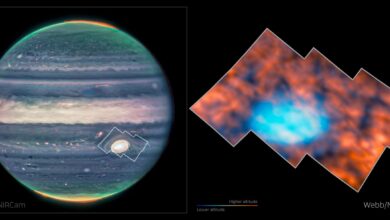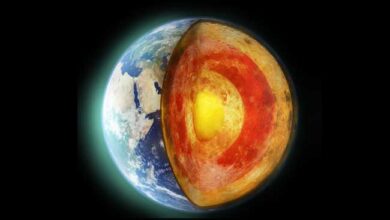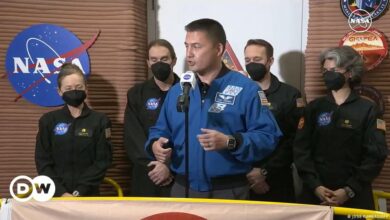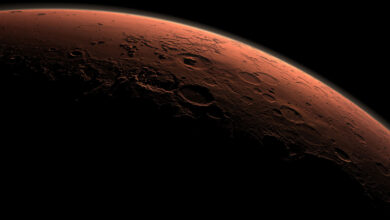How bad will hurricanes get? Scientists look for answers in ancient storms.
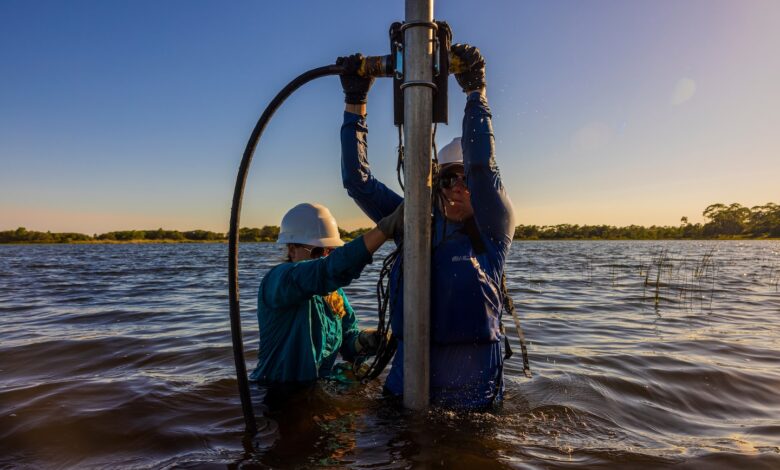
[ad_1]
Aboard a tiny pontoon, Elliott got low to guide a rigid plastic tube vertically underwater as her colleague Josh Bregy heaved a metal post driver up and down above her hardhat-covered head — ding! ding! ding! — to embed the tube deep into the bottom of the lake.
After hours on the water, they winched up a 1½-foot cylinder of lake bed. Sandwiched between sections of mud was what Elliott was looking for: a layer of sand, the potential remnants of a deadly storm that had hit the Florida Panhandle.
“It’s a beautiful example of a hurricane layer,” she said, running her finger down the clear tube.
This soggy, dirty work is part of a field of research called paleotempestology, the study of ancient hurricanes. The growing and relatively new science seeks to understand the storms that struck this and other coastlines before humans started recording the weather with modern instruments.
What researchers have found so far in that ancient mud offers a warning. Sifting through the sediment, paleotempestologists have spotted periods in which intense storms struck coastlines more frequently than current records show. Their work suggests oceans are capable of producing hurricane seasons far more relentless than anything modern society has seen so far.
Now, by burning fossil fuels and pumping heat-trapping gases into the air, the world risks re-creating those stormier conditions. Forecasters have already predicted that this year’s hurricane season, which started June 1, may be among the worst in decades. Hurricane Beryl, which exploded into a dangerous Category 4 hurricane Sunday, is forecast to charge across the Caribbean this week.
If the past is “any indication of what we’ll see,” Elliott said, “our coastal zones are really vulnerable.”
The hunt for ancient hurricanes
In 1989, Louisiana State University professor Kam-biu Liu was giving a lecture about the layers of ash left at the bottom of lakes by volcanic eruptions. A student, Miriam Fearn, asked if scientists can also see the marks left by hurricanes.
“That got me thinking. I said, ‘Of course, that should be doable,’” Liu said. That summer, he and Fearn found a layer of sand deep under an Alabama lake left by a 1979 storm.
Paleotempestology was supercharged after Category 5 Hurricane Andrew struck the Bahamas, Florida and Louisiana in 1992, killing dozens and causing billions of dollars in damage. The reinsurance industry, which financially backs home insurers and other insurance companies, pumped money into prehistoric hurricane research to better understand the risk of major storms.
“They really put their money where their mouth was, and really kick-started the field,” said Jeff Donnelly, another early ancient hurricane researcher at the Woods Hole Oceanographic Institution.
To predict how hurricane patterns will change in response to rising temperatures, climate scientists don’t have much to go on: roughly 170 years of instrumental data, a blink of an eye in Earth’s history. Paleotempestology holds the promise of extending the storm record by thousands of years and painting a more complete picture of how bad hurricanes can get.
When an intense hurricane makes landfall, the water crashes into beaches and carries waves of sand inland. If a lake is positioned just right along the coast, that material washes into it and settles on the bottom. By measuring radioactive carbon in those layers, paleotempestologists can figure out when a storm struck.
Over time, that coarse beach sand deposited by storms becomes encased in mud or sandwiched between layers of finer sand. In general, the more intense the storm, the coarser the sand, since it takes more power to sweep heavier grains to lakes.
Spotting a sandy hurricane layer among a bunch of other sand can be difficult — like “looking for hay in a haystack,” Elliott said.
Elliott knows persistence. She grew up in Michigan, helping her father build houses during summer breaks while in college studying geology. She said she used to get into tense conversations with her more conservative dad about climate change.
But more recently, she has taken the time to walk him through the data and answer his questions. “We just sat down and we talked about it,” she said. “And now we’ve moved to a place where he’s at least more willing to have the conversation and acknowledges something is changing.”
Here on Campbell Lake, in Florida’s Topsail Hill Preserve State Park, only a thin ridge of blinding white sand separates the freshwater body from the Gulf of Mexico. This is one of only a few places in the world with coastal dune lakes. Elliott, an up-and-coming ancient hurricane researcher, thought it was a perfect place to look for signs of old storms.
“Coastal lakes are by far our favorite place to core,” she said.
After embedding the tube in the lake bed, Elliott and Bregy, a scientist at Clemson University, took turns cranking a winch and pulling the cylinder by hand to haul up a sliver of the lake’s valuable sediment.
“This better be mud,” Bregy said. “Keep going, keep going, keep going,” urged Elliott. “It’s got to get out.” That first, 1½-foot core contained a sand layer from a relatively recent storm, probably Hurricane Opal in 1995.
To find older tempests, the team had to dig deeper into the lake bed — and into the past. Without a motor for the pontoon, Elliott and Bregy relied on their undergraduates in kayaks and a canoe to tow it across the nearly 100-acre lake.
Far from the shady pines along the lake’s edge, the small armada pulled the pontoon toward the middle of the lake. Another group of student sat on shore — on the lookout for alligators.
“Watch your heads,” said Bregy before he began to ding, ding, ding another hollow plastic tube down into the lake bed. Exhausted, he began imaging what he would eat that evening. “I’m going to get some ice cream tonight,” he said. “I’m going to get some strawberries.”
The next two cores were bigger: about 3 feet and 13 feet long. The longest probably dates back more than 10,000 years, Bregy said. Their chalky smell suggested they contain marine microfossils rich in calcium carbonate that can tell researchers which layers washed in from the ocean.
Once back on dry land, Elliott and Bregy high-fived.
Other Gulf Coast sediment cores reveal a period of intense hurricane activity in the region — worse than what we see today. It lasted for centuries before abruptly ending around 600 to 800 years ago.
What caused storms to rage and then subside? One theory is that a change in the position of a high-pressure system over the Atlantic called the Bermuda High may have nudged storms away from the Gulf Coast and toward the Eastern Seaboard. That would explain why New England lakes record an uptick in storms right after hurricane activity declined along the Gulf Coast.
Another factor is a torrent of warm water called the Loop Current, which runs through the Gulf of Mexico. It once flowed close to the shore before sliding south into the Gulf, a shift that lowered water temperatures and deprived storms of wind-churning energy.
The fact that the Gulf’s surface temperature is warming back up today due to climate change is worrying to those who study ancient hurricanes.
“What these records clearly show is that the climate system, outside of human interference, is already able to adjust itself in ways that give us activity like we haven’t seen in the last century or so,” Donnelly said. “The big question is, now that we are actually turning the knobs of climate ourselves, what’s the likely outcome?”
To find the answer, paleotempestologists are looking beyond the layers of sand for other evidence of hurricanes: exploring caves for drip deposits formed by cyclone rain, searching lakes for coral boulders washed by storms, scouring libraries for newspaper clips, ship logs and diary entries for accounts of hurricanes.
“When you have different techniques and they work together,” Liu said, “then that might be the best approach.”
Much of Elliott and Bregy’s work focuses on tree rings. Hurricanes leave subtle marks in coastal trees — at least when they aren’t blown down — as their rings record extreme precipitation and saltwater flooding from the past.
Bregy goes to great lengths to find old wood, harvesting it from remnant stumps and even excavated coffins. He recently got a tetanus shot after getting poked by a rusty nail while sampling lumber in an old attic.
“The problem here in the eastern U.S. is that there’s just been so much logging,” Bregy said. “It’s hard to find old living trees.”
Back on shore, Elliott knelt and used a power tool to cut one of the sediment cores in half. A thin strip of plastic curled off as she guided the device along the length of the tube. Always ready to offer a lesson, she helped one of her students complete the job.
“Beautiful,” she said, complimenting his work. He paused, but she urged him on. “You’re good, you’re good.”
A series of dark bands in the halved sediment core may be hurricane layers, though only a thorough lab analysis will reveal the truth. Elliot’s and Bregy’s labs will look for marine fossils, measure sand grain size and analyze isotope levels in order to gauge the intensity of old storms and figure out when they struck.
“This is the start of our work,” Elliott said.
In her hotel after the day of work on Campbell Lake, Elliott called her dad. “‘What did you see? What did you learn?’” she recalled him asking.
Later in a phone interview, Elliott’s father, Tony Timmons, acknowledged the climate is changing, though he “can’t get my arms wrapped around that it’s all man-made.” Having more scientists like his daughter look into climate change might make people more likely to accept it.
“Em will explain things to me and it makes it interesting to me, and I understand,” he said.
He added: “What she’s doing is important.”
[ad_2]
Source link

